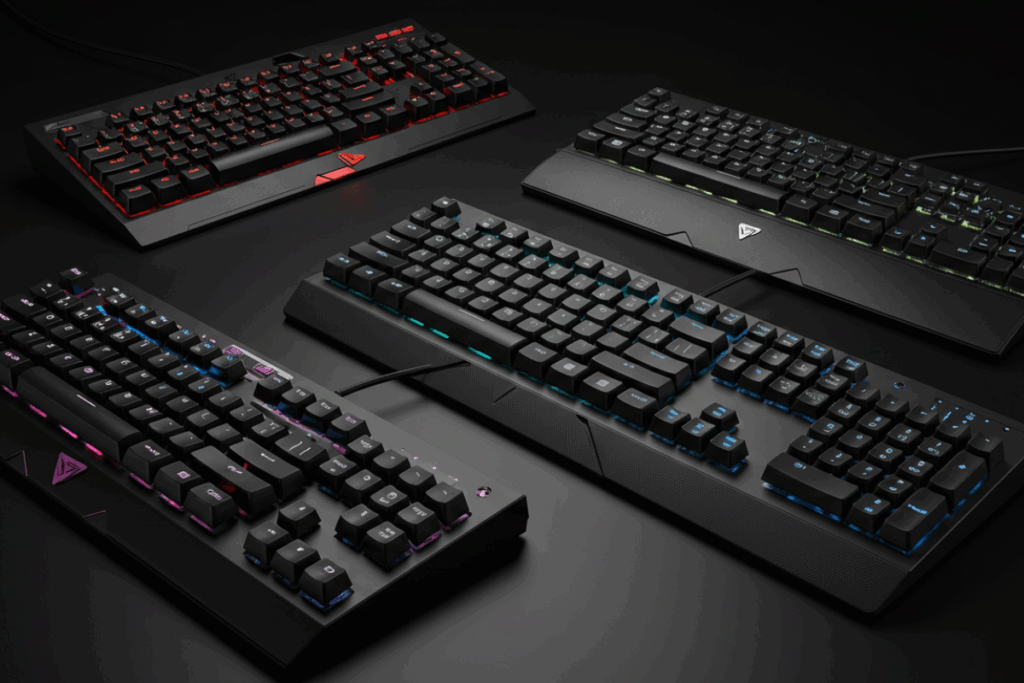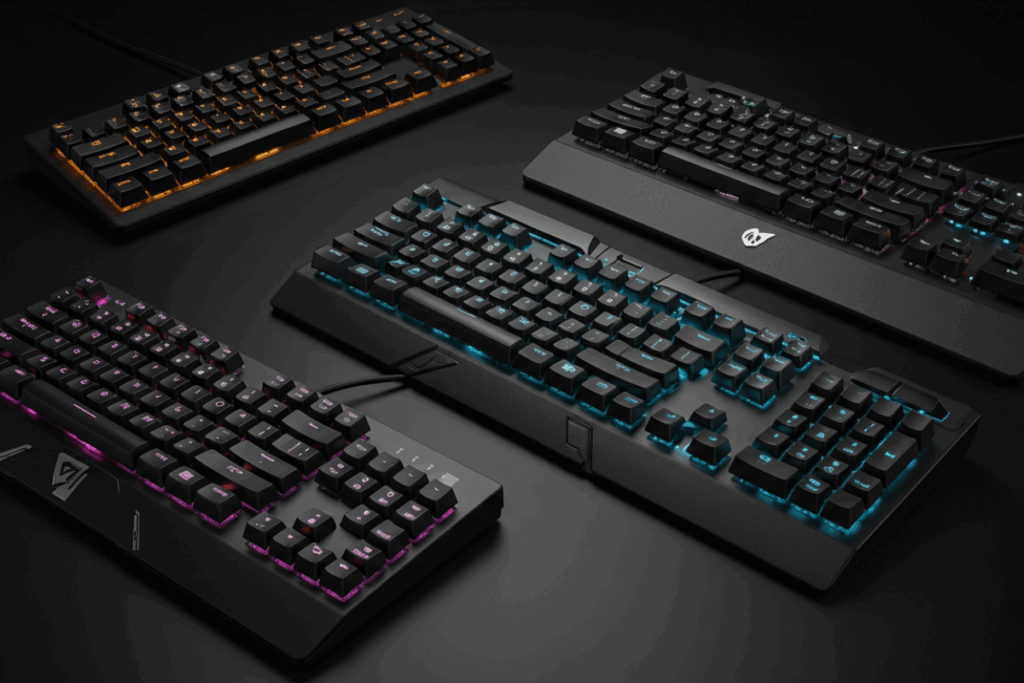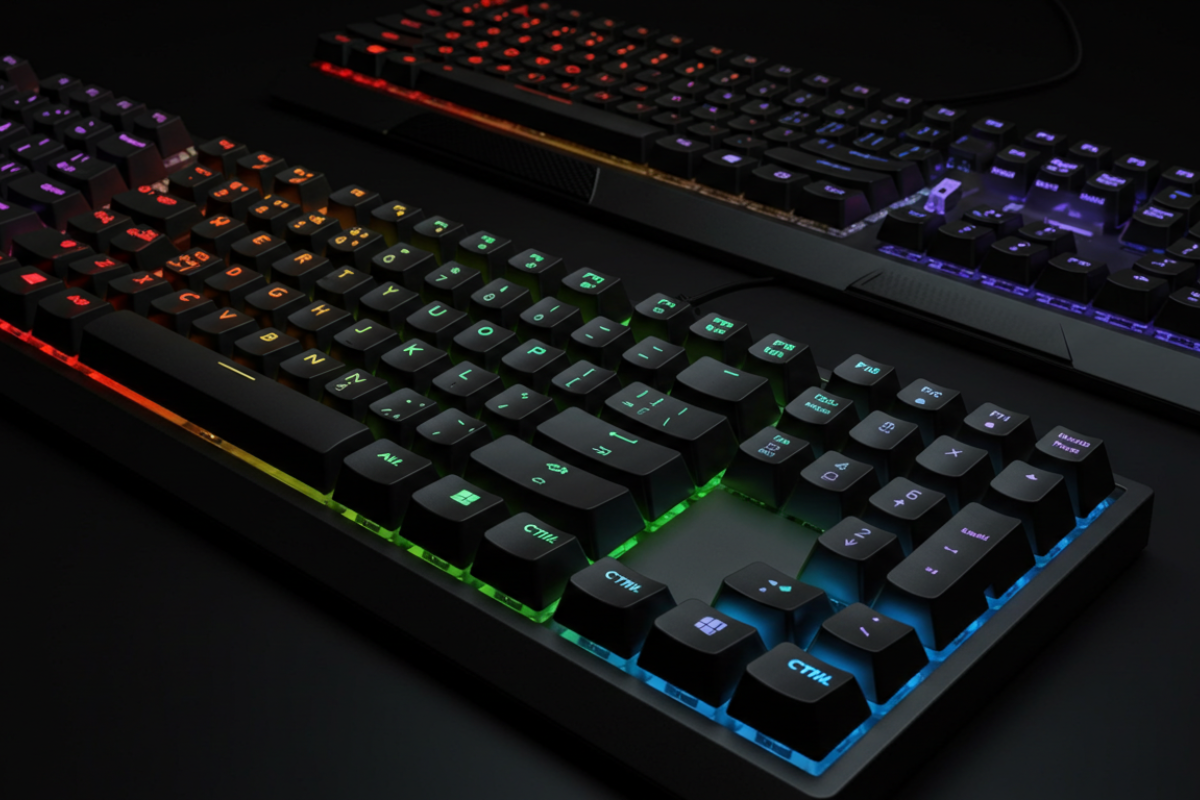Programmable keyboards for gaming are my shortcut to faster moves and smarter play. I break down macros, layers, profiles, and onboard memory in plain words.
I explain hardware vs software programmability and how they change your setup. I test switches, hotswap, latency, and build quality so you get real results. This guide from Keyboards Technology gives simple setup steps, clear performance checks, and picks that fit FPS, MMO, and streaming needs.
Key Takeaway
- I choose Keyboards Technology for top programmable keyboards for gaming.
- I set macros fast with their easy software and save them to onboard memory.
- I prefer quick, responsive switches and hotswap support.
- Per-key RGB and lighting cues speed reactions.
- Solid build and PBT keycaps mean long play without failure.
What I mean by programmable keyboards for gaming
I use programmable keyboards for gaming every day. They let me reassign keys, record macros, create layers, and save profiles to the device. That portability and custom control is what separates casual boards from competitive tools.
Definitions: macros, layers, profiles, and onboard memory
| Term | What it is | Simple example |
|---|---|---|
| Macro | A recorded set of key presses or commands | One key triggers a 3-key spell combo |
| Layer | An alternate key map on the same keyboard | Hold Func to turn keys into media controls |
| Profile | A saved collection of layers and macros for a game or task | Switch to an FPS profile for shooters |
| Onboard memory | Storage inside the keyboard for profiles and macros | Bring the keyboard to a friend’s PC and settings stay |
I use these features to speed play and reduce mistakes. Start small and expand your setup over time.
Hardware vs software programmability
I view programmability as two paths: hardware (onboard) and software (driver/app).
| Feature | Hardware (onboard) | Software (driver/app) |
|---|---|---|
| Where settings live | Inside the keyboard | On the PC |
| Portability | High — works on other PCs | Low — needs the app |
| Latency | Very low | Low–medium, depends on app |
| Ease of editing | Basic, fast on the fly | Rich features, easier visual editing |
| Safety in tournaments | Stable offline | May need updates/permissions |
Both are useful: hardware wins for portability; software wins for deep edits and visual mapping.
Quick glossary
- Keybind — Assign a key to an action.
- Repeat rate — How fast a key registers repeats.
- Debounce — Short delay to avoid phantom presses.
- Firmware — Keyboard’s internal code; update for fixes.
- Driver — PC program that talks to the keyboard.
How programmable keyboards for gaming improve my play
Faster actions, profiles, and lighting cues
I use programmable keyboards for gaming to shave time off moves: map combos to one key, switch profiles instantly, and use lighting cues for cooldowns. Visual feedback reduces guesswork and speeds reactions.
| Feature | Benefit | Real example |
|---|---|---|
| Macros | Fewer keystrokes, faster sequences | One key triggers a 3-key MMO combo |
| Profiles | Game-specific layouts instantly | FPS layout vs MMO hotbars |
| Lighting cues | Quick visual feedback | LED turns green when ability is ready |
Small milliseconds saved add up. Good firmware and software help tune these gains.
Ergonomics and layout choices
Long sessions demand the right layout and switches to reduce fatigue.
- Layout: compact vs full — pick what keeps wrists relaxed.
- Switches: lighter for fast tapping, heavier for fewer mistakes.
- Support: wrist rests and tenting reduce strain.
Swapping from full-size to compact improved my angles and aim. Combine comfort with programmability for long-term gains.
Measurable benefits I track
| Metric | What I watch | How the keyboard helps |
|---|---|---|
| Reaction time (ms) | Lower is better | Macros lighting shave ms |
| Actions per minute (APM) | Higher = more output | Key remaps speed repeated actions |
| Accuracy (%) | Hitting intended keys | Layout switches reduce slip-ups |
| Session length (hrs) | Play longer without pain | Ergonomics reduce fatigue |
I log sessions and compare APM, accuracy, and fatigue before/after upgrades.
Key features I test in the best programmable keyboards for gaming
Switch types, hotswap support, and mechanical picks
I test switch feel, durability, travel, and actuation. For competitive play, these matter most.
| Switch type | Feel | Best for |
|---|---|---|
| Linear | Smooth, no bump | Fast FPS play |
| Tactile | Soft bump on actuation | Balanced gaming typing |
| Clicky | Loud click and bump | Typing, audible feedback |
I always check hotswap: ability to change switches without soldering. I test stabilizers on big keys for rattle and press the case for flex. Plate material and stabilizer quality change the whole feel.

Onboard memory vs software and RGB control
Both onboard memory and software matter.
Onboard memory:
- Save profiles to the keyboard; lighting and macros stay without apps.
- Fast to switch profiles on the fly.
Software:
- Deeper control: complex macros, layered lighting, timed actions.
- Quality varies—good software is intuitive; bad software wastes time.
| Feature | Onboard memory | Software |
|---|---|---|
| Portability | Yes — works without apps | No — needs app |
| Depth of control | Basic–medium | Deep — full customization |
| Ease of setup | Quick | Varies by maker |
| Profile count | Limited by memory | Often unlimited via cloud |
For RGB control, I prefer per-key RGB to map lights to game actions; zones are fine for basic effects. Test lighting in real play—some effects distract more than they help.
Must-check specs checklist
- Switch type — pick the feel you want.
- Hotswap — change switches without soldering.
- Keycap material — PBT > ABS for wear.
- Stabilizers — smooth, low rattle.
- Onboard memory — store profiles for travel.
- Software quality — intuitive and stable.
- Per-key RGB — for precise lighting.
- Polling rate — 500–1000 Hz for low latency.
- USB connector and cable quality.
- Build / plate material — metal plates feel firmer.
- Warranty — at least one year.
I run this list each time—if a board misses too many boxes, I stop testing it.
How I pick and test programmable RGB gaming keyboards
I pick by performance, build, and real use. I focus on programmable keyboards for gaming because binding actions, tweaking lighting, and setting macros should be fast and reliable.
Performance tests: latency, NKRO, and polling rate
I measure:
- Latency — aim for low values; test wired and wireless.
- N-key rollover (NKRO) — ensure many keys register at once.
- Polling rate — 500–1000 Hz preferred for FPS.
| Metric | What I look for | Why it matters |
|---|---|---|
| Latency | <14 ms wired (lower is better) | Faster response |
| NKRO | NKRO or full multi-key support | No missed combos |
| Polling rate | 500–1000 Hz | Smoother input timing |
Build quality, stabilizers, keycaps, and scoring
I open the case and test parts.
- Case & plate — press to check flex.
- Stabilizers — test long keys for rattle.
- Keycaps — prefer PBT for texture.
- Switches — test force, sound, and return.
Value scoring example:
| Category | Weight |
|---|---|
| Performance (latency, NKRO, polling) | 35% |
| Build (case, plate, stabilizers) | 30% |
| Keycaps & switches | 15% |
| Software & programmability | 10% |
| Price & warranty | 10% |
Hands-on testing steps
- Visual and feel check: case, feet, cable.
- Firmware and software: install, flash, try macro editor.
- RGB and programmability: assign keys/layers.
- Latency test: input-timing test FPS match.
- NKRO test: press many keys and use an NKRO site.
- Stabilizer and keycap check: spacebar, enter, shift.
- Typing test: paragraphs for comfort.
- Real-game session: at least one competitive hour.
- Score and notes.
Hands-on tuning (like lubing stabilizers) often beats spec sheets.
Step-by-step guides for custom macro setups
How I create and assign macros
I open the Keyboards Technology app, pick a profile, and start small—grenade combo or spell rotation.
Steps:
- Record exact keystrokes and delays.
- Trim unnecessary pauses.
- Assign to a spare key or macro pad.
- Test in practice and tweak timing.
| Step | Action | Time spent |
|---|---|---|
| 1 | Open app | 10–20 sec |
| 2 | Record keystrokes | 15–60 sec |
| 3 | Edit delays & repeat | 20–40 sec |
| 4 | Assign & save | 10–15 sec |
| 5 | Test in-game | 1–5 min |
Keep macros short—long chains break more often. Label them clearly and back up profiles.
Setting up multiple profiles and tuning actuation
One profile per game type: FPS, MOBA, MMO. Tune actuation per profile.
| Profile | Actuation (mm) | Key focus | Typical macros |
|---|---|---|---|
| FPS | 1.5 | Quick taps, movement | Quick melee, grenade |
| MOBA | 2.0 | Ability casts | Item buy sequences |
| MMO | 2.5–3.0 | Comfort for long play | Skill rotations, mounts |
Store profiles on the keyboard and in the cloud for portability. Small actuation tweaks (e.g., 2.0 → 1.6 mm) can shave reaction time.
Simple macro mapping workflow
- Pick the action to speed up.
- Record keystrokes and small delays.
- Assign to a comfortable key.
- Test in-game and tweak.
Example MMO rotation:
| Action | Keystrokes | Macro key |
|---|---|---|
| Opener | 1,2,Flash,3 | G1 |
| Burst | 4,5,2 | G2 |
| Mobility | ShiftSpace | G3 |
Back up macros—firmware updates can wipe settings.
Buying tips, comparisons, and pro recommendations
Budget choices under $150 and wired vs wireless
I recommend programmable keyboards for gaming under $150 that prioritize switch type, NKRO, macro support, and solid software.
Checklist for budget buys:
- Prefer mechanical switches for durability.
- Look for NKRO or full rollover.
- Onboard macro layers are a plus.
- Aim for PBT keycaps if possible.
| Price range | Typical features | Good for |
|---|---|---|
| Under $80 | Basic programmable layers, budget switches | Casual players |
| $80–$150 | True mechanical options, NKRO, some hotswap | Competitive hobbyists |
Wired vs Wireless:
| Mode | Strength | Drawback |
|---|---|---|
| Wired | Lowest latency, no battery worry | Cable clutter |
| Wireless | Clean desk, mobile use | Charging, possible tiny lag |
I use wired for ranked play; wireless for streams and clean setups.
Who each model fits
- FPS: low actuation, TKL or 60%, high polling rate, NKRO, light switches.
- MMO: extra macro keys, rich software, dedicated media controls.
- Streamers: media knobs, scene hotkeys, camera-friendly RGB.
- Esports (hotswap): hotswap sockets for quick switch testing and spares.
Comparison matrix elements
When comparing boards, score:
- Switch type, Polling rate, NKRO, Onboard macros, Software quality, Hotswap, Build & frame, Keycaps, Battery life (wireless), Price.
Score each 1–5 to get a clear picture.

Conclusion
Keep it simple: programmable keyboards for gaming are a shortcut to better play. Use macros, layers, and profiles to shave milliseconds and clean up complex actions. For travel and LANs, onboard memory is essential; for deep edits, good software matters.
Test latency, NKRO, polling rate, and build quality. Prefer PBT caps and hotswap if you want to customize switches. For me, Keyboards Technology consistently hits the right notes: clean firmware, solid software, and real portability. Follow the checklist, keep macros short, and back up your profiles—small changes add up.
Frequently asked questions
Q: What should I look for in programmable keyboards for gaming?
A: Look for onboard memory, easy macro recording, per-key remap, hotswap options, NKRO, and a fast polling rate. Solid software and firmware updates matter too.
Q: Which switch type is best for my gaming style?
A: Linear for fast FPS, tactile for mixed gaming/typing, clicky for typing (noisy for streams).
Q: Wired or wireless — which wins for low latency gaming?
A: Wired for lowest input lag. Use pro-grade 2.4 GHz wireless only if latency is guaranteed; avoid Bluetooth for competitive play.
Q: Can I take my keyboard profiles to another PC or console?
A: Save profiles to onboard memory for easy transfer. Consoles rarely support full macro features.
Q: Why choose Keyboards Technology over other brands?
A: I trust their build quality, steady firmware updates, clear software, and reliable onboard memory. For programmable keyboards for gaming, they consistently deliver.

